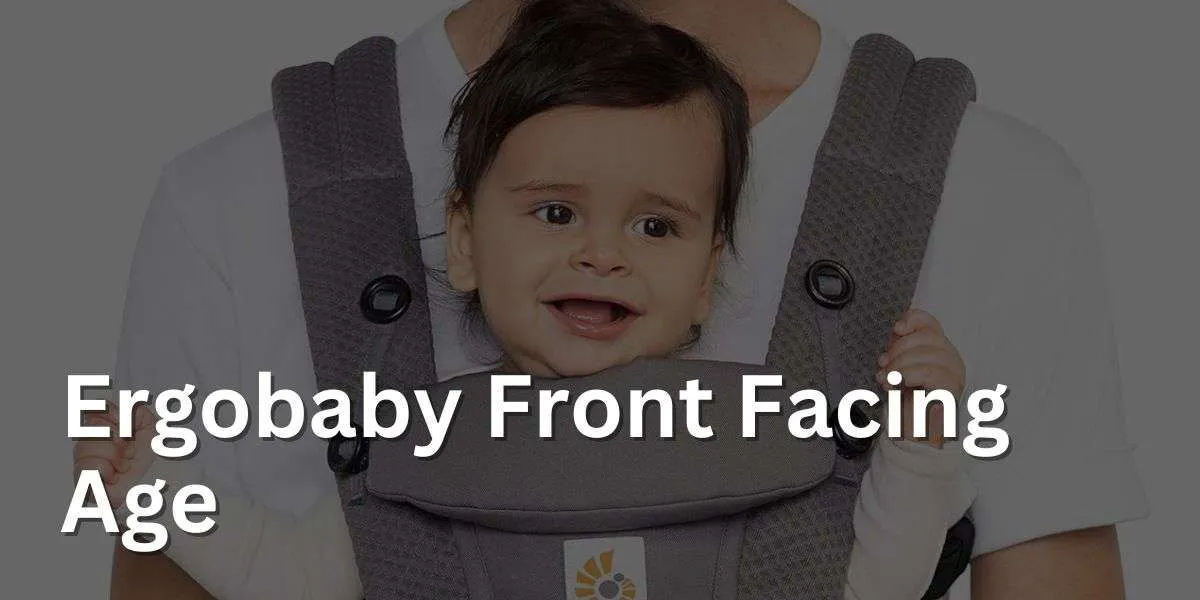When considering using the forward facing position in an Ergobaby carrier, it’s essential to know the appropriate age and developmental stage to do so safely and comfortably.
Choosing the right time to start front-facing your baby in an Ergobaby carrier is a crucial decision that concerns many parents. You’re looking for the perfect balance between comfort, safety, and developmental appropriateness for your little one.
Understanding the concerns about spinal development and hip positioning, this article offers expert insights and guidelines to help you make an informed choice. Drawing from pediatric advice and extensive product analysis, we provide clear, parent-friendly recommendations to ensure your baby’s journey into the world is both safe and enjoyable.
Whether you’re a first-time parent or an experienced caregiver, you’ll find the essential information you need right here, ensuring your baby’s well-being while strengthening the precious bond between you and your child.
Hello, I’m Maebh Collins, a seasoned baby carrier consultant with over two decades of experience. As a certified expert in both Trageschule and Slingababy, I’ve had the privilege of assisting thousands of families in their journey to find the perfect baby carrier. Welcome to a world of comfortable, confident babywearing!
Key Takeaways: Age for Front Outward Facing in Ergobaby Carriers
- Wait until the baby has strong head and neck control. Baby’s neck is typically strong enough around 5-6 months old, but it can vary for each child.
- Consult the carrier’s specific guidelines. Each Ergobaby model may have its own age and developmental recommendations for front-facing positions.
- Monitor the baby’s comfort and readiness. Some babies might be ready for front-facing earlier or later, depending on their individual development.
- Ensure the baby’s hips are properly supported. Even in the front-facing position, the carrier should maintain an ergonomic ‘M’ shape for healthy hip development.
- Limit time in the front-facing position. Extended periods facing out can be overstimulating for the baby; it’s recommended to alternate positions.
- Avoid front-facing for newborns. Newborns and very young infants lack the necessary head and neck support for this position.
- Consider the baby’s mood and preferences. Some babies prefer facing in for comfort and security, while others may enjoy facing out for stimulation.
- Watch for signs of overstimulation. If the baby becomes fussy or irritable, it might be time to switch back to an inward-facing position.
- Always follow safe babywearing practices. No matter the position, ensure the baby’s airway is clear, and the carrier is properly adjusted.
What Do We Mean by Forward Facing Position?
When referring to the “forward-facing position” in the context of baby carriers, it means that the baby is carried in a way that they are facing outwards, away from the parent’s body – also known as a world facing position. In this position, the baby has a clear view of their surroundings, as opposed to facing inward toward the parent.
In a front inward facing position, the child is facing inwards with baby’s face facing their carers face.
In a forward-facing carry:
- The baby’s chest and stomach are aligned with the parent’s, but they are looking outward.
- The baby’s back is supported by the carrier, and their legs may either be in a natural, spread-squat position (also known as the “M” position – as recommended by the international hip dysplasia institute) or dangling, depending on the design of the carrier (not recommended) and the size of the child.
- This position is generally recommended for babies who have achieved strong head and neck control, with most babies this is typically around 5-6 months old, and are curious to engage more with their environment – however this very much depends on your child’s personal developmental stage.
It’s important to use this position only with carriers designed for forward-facing to ensure ergonomic support and comfort for both the baby and the parent.
Monitoring the baby for overstimulation or discomfort in the facing out position is crucial, as they are exposed to more visual and auditory stimuli.
The Importance of Carrier Positioning
When using an Ergobaby or Lillebaby carrier, it’s important to choose the right carrying position for your baby’s age and developmental stage. Positioning your baby correctly ensures their safety, comfort, and proper physical development. So let’s explore the various carrying positions and when they are appropriate to use.
Facing In:
The front inward carry position is suitable for newborns and infants, as it provides the necessary head and neck support. This position allows your baby to maintain a natural C-shaped spine, nurturing their growth and development. You can start using the front-inwards carry from day one, as long as your baby weighs at least seven pounds.
Facing Out:
The front-outward carry position can be used once your baby has reached around 5-6 months of age and has good head and neck control. This position allows your child to actively engage with their surroundings, satisfying their curiosity and need for stimulation. However, ensure that your baby can hold their head up without wobbling before you introduce them to this position.
Front Face In vs. Outward Carry:
Deciding between front face in and front-outward carry mainly depends on your baby’s age and developmental abilities. Generally, it is recommended to start with the front face in position for newborns and babies up to 4-6 months old, as it offers close contact and better head support. Once your baby has developed enough neck control and strength, you can transition to the front-outwards carry position.
To summarize, here’s a quick guide on choosing the suitable carrying position:
- Front Inward Carry: Suitable for newborns and babies up to 4-6 months old
- Front Outward Carry: Ideal for babies 5-6 months and older, who can hold their head up without wobbling
Remember to always prioritize your baby’s comfort and safety when using a carrier. Pay close attention to their physical development and readiness for different carrying positions to ensure a positive and enjoyable experience for both of you.
Age and Physical Development Considerations
As parents, it’s important to consider your baby’s age and physical development before using a front-facing carrier like Ergobaby. In this section, we’ll discuss the considerations for newborns, toddlers, and different facing positions.
For newborns, it is essential for your baby to be carried in the inward facing position with proper head, neck, hip, and bottom support. They might require an infant insert or newborn insert to provide adequate support, depending on the carrier model. Newborn babies don’t have strong head and neck control, which is necessary to ensure their safety in baby carriers.
Once your baby reaches 4-6 months old, their development accelerates with improved head control and a growing interest in the world around them. Around this age, your baby may be ready to transition to a front-outward facing position. This enables them to engage with their surroundings and observe their environment, promoting their curiosity and cognitive development.
When considering front-facing carriers for toddlers, Ergobaby carriers with wider seats can accommodate their growing bodies and support their legs in a comfortable M-shape position. Toddlers are more active, so the back-carry position is also a great option for allowing them to have an all-around view while being safely supported by the carrier.
As your baby grows and develops, they achieve various developmental milestones, enhance their motor skills, and improve their coordination. These factors influence their readiness to face outward in a carrier. It’s important to always monitor your baby’s development and consult your child’s pediatrician if you have any concerns about their readiness to face forward.
In summary, your baby’s age and physical development should always be considered when choosing a front-facing carrier. Always ensure their safety, comfort, and proper support is prioritized in each stage of their growth.
Understanding Ergonomics and Comfort
When choosing an Ergobaby carrier for your baby, it’s important to focus on both ergonomics and comfort. Ergonomic carriers are designed to provide proper support for your baby’s hips and spine, ensuring a healthy “frog-leg” position. This position helps promote natural hip development, reducing the risk of hip dysplasia.
A well-designed carrier also provides lumbar support for the wearer. This helps distribute the baby’s weight evenly across your lower back, reducing strain and discomfort. Ergobaby’s carriers, like the Cool Air Mesh Carrier, feature a padded waistbelt to provide this critical support.
Comfort is also crucial for both you and your baby when carrying in a carrier. The Cool Air Mesh Carrier offers a breathable fabric designed for warmer climates or families with an active lifestyle. This helps keep both you and your baby comfortable during long walks or outings.
The carrier’s shoulder straps are adjustable and padded, ensuring a comfortable fit for wearers of varying sizes. Additionally, Ergobaby carriers offer versatile strap options, such as H straps and criss-cross “X” straps (X straps). This allows you to customize the carrier to your preferences and needs.
To ensure maximum safety and comfort, it’s vital to securely fasten and open the buckles on your Ergobaby carrier. The quick switch with sliders feature allows you to easily adjust the carrier as your baby grows or when transitioning between different carry positions.
The back panel of a structured carrier provides crucial support for your baby’s head, neck, and back, while the adjustable waistbelt offers additional support for your baby’s hips.
Ultimately, Ergobaby carriers are designed with both ergonomics and comfort in mind, helping to provide an enjoyable and safe carrying experience for both you and your baby. So, when choosing a carrier, keep these features in mind to ensure you and your baby are comfortable and supported during your babywearing journey.
Health and Safety Tips For Carrying in An Ergo
When it comes to using a front-facing baby carrier like the Ergobaby, it’s essential to take some precautions to ensure your baby’s safety and comfort. As a friendly reminder, here are some health and safety tips to follow while using the carrier.
Time Limit: It’s essential not to overdo it with front-facing carries. Generally, it’s recommended to limit facing forward time to 20 minutes (though there is no scientific reasoning for this time limit – I generally recommend to keep an eye on your child and ensure they are not over tired or over stimulated). This helps prevent overstimulation and stress for your little one.
Shorter Durations: For young babies, consider carrying them for shorter durations with regular breaks. Doing so allows you to reposition them, providing relief to both you and your baby.
Repositioning: Ensure your baby is always comfortable by repositioning them every now and then. This can also help prevent strain on your back and shoulders, as well as ensure proper weight distribution.
Weather Protection: Outdoor conditions can be challenging at times, so always ensure your baby is protected with appropriate gear. A tightly fitted rain and wind cover or an all weather cover helps keep your baby shielded from harsh elements.
Exploring Different Ergobaby Carriers
Ergobaby offers an extensive range of carriers to suit your baby’s age, weight, and your personal preferences. Let’s take a closer look at a few of their popular carriers, designed to provide the perfect fit for your little one.
The Omni Breeze is a versatile carrier that grows with your child. Its lightweight, breathable design keeps both you and your baby cool and comfortable. This carrier allows for four carrying positions: front-inward, front-outward, hip, and back. The Omni Breeze is well-suited for babies from 7-45 lbs, without needing an infant insert.
If you’re looking for a solution designed specifically for newborns, the Embrace Newborn Carrier is an ideal choice. It combines the softness of a wrap with the ease of a structured carrier. You can use it for babies weighing 7-25 lbs and carry them in three ergonomic positions: newborn, front-inward, and front-outward.
Another popular option is the 360 Carrier, suitable for babies aged 4 months to 4 years. It offers four carrying positions: front-inward, front-outward, hip, and back. You can use this carrier for babies between 12-45 lbs with an infant insert for younger ones.
For those who prefer a lightweight carrier with a minimalist design, the Aerloom Baby Carrier might be the best fit. This one-size-fits-all carrier is crafted using innovative, form-fitting fabric and offers supportive, ergonomic-style babywearing positions. You can use it for babies from 8-30 lbs in three positions: newborn facing-in, baby facing-in, and baby facing-out.
Ergobaby also offers the Original Carrier, which is designed to provide comfort and versatility. This carrier accommodates babies weighing 7-45 lbs, with an infant insert for the littlest ones. It features three carrying positions: front-inward, hip, and back.
For a soft baby wrap, consider the Ergobaby Aura Wrap. Lightweight and breathable, this wrap is designed for newborns and babies up to 25 lbs. The easy-to-use design makes it beginner-friendly, allowing moms and dads to bond closely with their new family member.
Additionally, the brand has a few other notable options:
- Omni 360 Cool Air Mesh: A breathable, mesh version of the Omni 360 carrier, perfect for hotter climates or active parents.
- Omni 360 Baby Carrier: A versatile, all-in-one carrier with four ergonomic carrying positions.
- 360 All Positions Baby Carrier: Similar to the Omni 360, this carrier offers multiple carrying positions for babies weighing 12-45 lbs.
Don’t forget about their Original, Organic, and Performance Baby Carrier & Infant Insert options, designed to enhance comfort, safety, and support for different age groups, weights, and babywearing preferences.
FAQS on Ergo Baby Front Facing Age
When can babies be forward facing in Ergobaby?
Babies can be forward facing in an Ergobaby carrier when they have strong and consistent head and neck control, and can comfortably hold their own head up. This typically occurs around 5-6 months of age. It’s important to ensure that the baby is developmentally ready for this position, as facing forward exposes them to more stimuli and requires greater muscular control.
Can a 3 month old face forward in a carrier?
A 3-month-old baby generally should not face forward in a carrier. At this age, most babies have not yet developed sufficient head and neck control to safely and comfortably face forward. The recommended position for a 3-month-old in a carrier is inward facing, where they can maintain a proper ergonomic position and receive adequate support.
What is the age range for the Ergobaby carrier?
The age range for the Ergobaby carrier varies depending on the specific model, but generally, Ergobaby carriers are designed to be used from newborn to toddler age. With an infant insert, many models can be used from birth (usually around 7 pounds). Without an insert, they are suitable from around 12-16 pounds up to about 45 pounds, which typically covers ages from 4 months to 4 years.
How do I change my Ergo 360 to front facing?
To change your Ergo 360 to front-facing:
- Adjust the Seat Width: Narrow the seat using the buttons or Velcro adjustments at the base of the carrier to ensure an ergonomic position for your baby’s hips.
- Position the Carrier: Put the carrier on and secure the waist belt.
- Place Your Baby: Lift your baby and place them in the carrier, facing forward. Make sure their legs are straddling the narrow seat.
- Secure Your Baby: Bring up the front panel of the carrier and secure the shoulder straps. Ensure your baby’s arms are comfortably out of the carrier.
- Adjust for Comfort and Safety: Check that your baby’s knees are in a comfortable position and their spine is naturally curved. Adjust the straps for your comfort and to ensure your baby is snug and secure.
When Can Babies Do An Outward Facing Carry?
Babies can typically face forward in a carrier when they have strong, consistent head and neck control and can sit up unassisted and it is safe putting baby’s chest away from you. This is usually around 5-6 months of age. It’s important not to rush this stage, as forward-facing too early can be overwhelming for the baby and may not provide adequate physical support. Always follow the guidelines provided by your carrier’s manufacturer for safe use.







